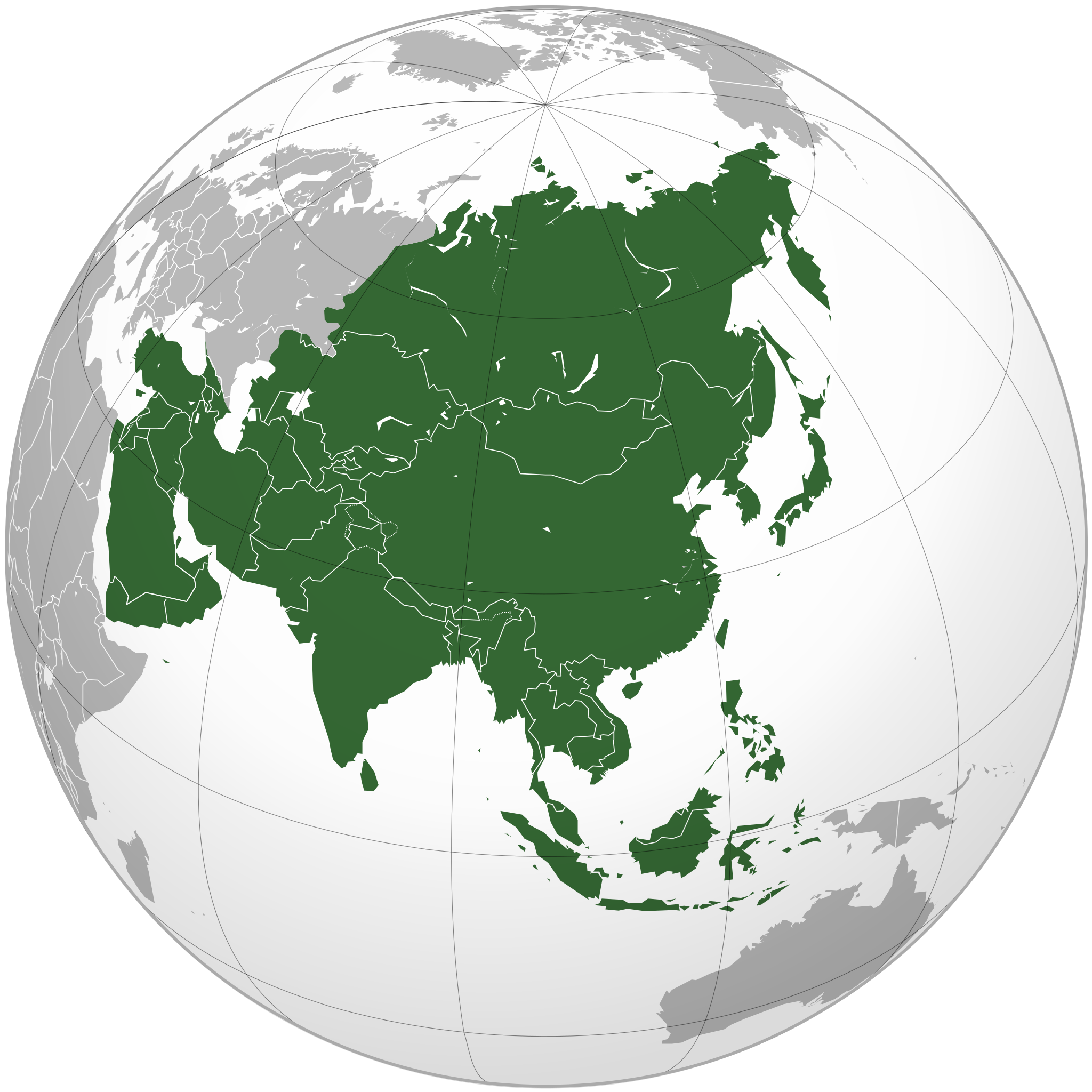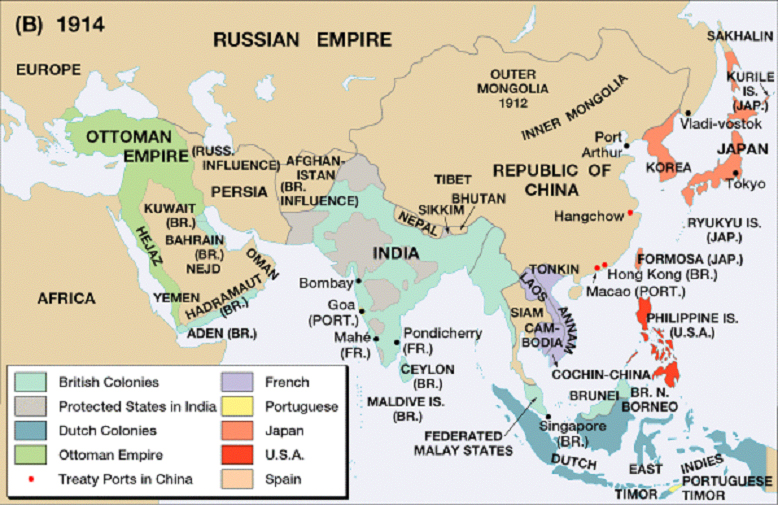Verda.Majo (talk | contribs) mNo edit summary Tag: Visual edit |
Verda.Majo (talk | contribs) Tag: Visual edit |
||
| Line 16: | Line 16: | ||
== Western imperialism in Asia == | == Western imperialism in Asia == | ||
[[File:Imperialism in Asia in 1914.jpg|thumb|A depiction of imperial powers in Asia as of 1914.]] | [[File:Imperialism in Asia in 1914.jpg|thumb|A depiction of imperial powers in Asia as of 1914.]] | ||
European-style [[Colonialism|colonial]] empires and [[imperialism]] and their effects have operated in Asia for centuries, and much of Asia's modern history is entangled with its relationship to Western colonialism. Western colonialism in Asia originated in the 15th-century search for trade routes to the Indian subcontinent and Southeast Asia that led to a period of extensive overseas exploration by Europeans, with the [[Portuguese Republic|Portuguese]] and the [[Kingdom of Spain|Spanish]] at the forefront, later joined by the [[Kingdom of the Netherlands|Dutch]], the [[United Kingdom of Great Britain and Northern Ireland|English]] and the [[French Republic|French]]. The era saw the widespread enslavement, exploitation and military subjugation of native populations and the extraction of their natural resources, concurrent with the growing economic influence and spread of European culture and technology. Several different Western European powers eventually established colonies in Asia, and by the end of the nineteenth century, | European-style [[Colonialism|colonial]] empires and [[imperialism]] and their effects have operated in Asia for centuries, and much of Asia's modern history is entangled with its relationship to Western colonialism. Western colonialism in Asia originated in the 15th-century search for trade routes to the Indian subcontinent and Southeast Asia that led to a period of extensive overseas exploration by Europeans, with the [[Portuguese Republic|Portuguese]] and the [[Kingdom of Spain|Spanish]] at the forefront, later joined by the [[Kingdom of the Netherlands|Dutch]], the [[United Kingdom of Great Britain and Northern Ireland|English]] and the [[French Republic|French]]. The era saw the widespread enslavement, exploitation and military subjugation of native populations and the extraction of their natural resources, concurrent with the growing economic influence and spread of European culture and technology. Several different Western European powers eventually established colonies in Asia, and by the end of the nineteenth century, much of the region was under European colonial rule.<ref name=":1">[https://world101.cfr.org/rotw/south-asia/modern-history#overview “South and Central Asia | Modern History.”] 2022. World101 from the Council on Foreign Relations.</ref> | ||
Noteworthy entities in the European colonization of Asia were the [[British East India Company]], a powerful international corporation backed by a military force,<ref>Dalrymple, William. 2015. [https://www.theguardian.com/world/2015/mar/04/east-india-company-original-corporate-raiders “The East India Company: The Original Corporate Raiders.”] The Guardian. March 4, 2015. [https://web.archive.org/web/2/https://www.theguardian.com/world/2015/mar/04/east-india-company-original-corporate-raiders Archived] 2022-08-14.</ref> and its competitor, the similarly powerful [[Dutch East India Company]], which began to exert control over their regions of operation and take on governmental functions. At its peak, the small group of merchants of the British East India Company ruled over two hundred million people, and it can be said to have created the infrastructure the British would use after they formally colonized the region in the mid-nineteenth century.<ref name=":1" /> | Noteworthy entities in the European colonization of Asia were the [[British East India Company]], a powerful international corporation backed by a military force,<ref>Dalrymple, William. 2015. [https://www.theguardian.com/world/2015/mar/04/east-india-company-original-corporate-raiders “The East India Company: The Original Corporate Raiders.”] The Guardian. March 4, 2015. [https://web.archive.org/web/2/https://www.theguardian.com/world/2015/mar/04/east-india-company-original-corporate-raiders Archived] 2022-08-14.</ref> and its competitor, the similarly powerful [[Dutch East India Company]], which began to exert control over their regions of operation and take on governmental functions. At its peak, the small group of merchants of the British East India Company ruled over two hundred million people, and it can be said to have created the infrastructure the British would use after they formally colonized the region in the mid-nineteenth century.<ref name=":1" /> | ||
Revision as of 08:11, 14 August 2022
| Asia | |
|---|---|
 | |
| Area | |
• Total | 44,579,000 km² |
| Population | |
• 2018 estimate | 4,560,667,108 |
Asia is the largest and most populated continent in the world.[1] The population of Asia makes up about 60% of the world population.[2][3] It shares the continental landmass of Eurasia with the continent of Europe, and the continental landmass of Afro-Eurasia with Africa and Europe. In general terms, Asia is bounded on the east by the Pacific Ocean, on the south by the Indian Ocean, and on the north by the Arctic Ocean. The border of Asia with Europe is a historical and cultural construct, as there is no clear physical and geographical separation between them.
The PRC, DPRK, Vietnam, and Laos are all located in Asia. Russia is commonly considered to span both Europe and Asia, with most of Russia's territory being located in the Asian continent, while most of the country’s population resides in the European side.[4] Kazakhstan also has contiguous territory in both Europe and Asia. The Ural River, which flows into northwestern Kazakhstan, is considered to be part of the border between Europe and Asia.[5] Turkey is also commonly considered to be located in both Europe and Asia.[5][6] Egypt is a country whose territory is located mostly in North Africa. A part of Egyptian territory, known as the Sinai Peninsula, is considered to be part of Asia and serves as a land bridge between Africa and Asia.[5]
Asia varies greatly across and within its regions with regard to ethnic groups, cultures, environments, economics, historical ties and government systems. It also has a mix of many different climates including desert, subtropical, temperate, subarctic, and polar areas.
Regions
Asia is often conceptually divided into several subregions, although there is no universal consensus on these divisions, and many have overlapping or flexible demarcations.
Some commonly described regions of Asia include Central Asia, East Asia, South Asia, Southeast Asia, West Asia (also commonly called the Middle East), and North Asia (also commonly called Siberia).
Western imperialism in Asia

European-style colonial empires and imperialism and their effects have operated in Asia for centuries, and much of Asia's modern history is entangled with its relationship to Western colonialism. Western colonialism in Asia originated in the 15th-century search for trade routes to the Indian subcontinent and Southeast Asia that led to a period of extensive overseas exploration by Europeans, with the Portuguese and the Spanish at the forefront, later joined by the Dutch, the English and the French. The era saw the widespread enslavement, exploitation and military subjugation of native populations and the extraction of their natural resources, concurrent with the growing economic influence and spread of European culture and technology. Several different Western European powers eventually established colonies in Asia, and by the end of the nineteenth century, much of the region was under European colonial rule.[7]
Noteworthy entities in the European colonization of Asia were the British East India Company, a powerful international corporation backed by a military force,[8] and its competitor, the similarly powerful Dutch East India Company, which began to exert control over their regions of operation and take on governmental functions. At its peak, the small group of merchants of the British East India Company ruled over two hundred million people, and it can be said to have created the infrastructure the British would use after they formally colonized the region in the mid-nineteenth century.[7]
Central Asia saw power competition between Great Britain and Russian Empire during the 19th century. This was a period of Russian expansion and the moves made by Britain to counter what they perceived as Russian aggression in the region, which they believed would threaten their colonial influence in India. This period includes the First Anglo-Afghan War.[9]
References
- ↑ "Population of Asia". Populationof.net. Archived from the original on 2021-10-29. Retrieved 2022-01-16.
- ↑ “Global Population: Distribution by Continent 2021 | Statista.” Statista. 2021. Archived 2022-08-14.
- ↑ “Population of Asia (2022) - Worldometer.” 2022. Worldometers.info.
- ↑ Shvili, Jason. 2021. “Is Russia in Europe or Asia?” WorldAtlas. March 26, 2021.
- ↑ 5.0 5.1 5.2 Shvili, Jason. 2021. "Transcontinental Countries of the World.” WorldAtlas. May 7, 2021.
- ↑ Sally Polly. “Is Turkey in Europe or Asia?” KnowInsiders. September 20, 2021.
- ↑ 7.0 7.1 “South and Central Asia | Modern History.” 2022. World101 from the Council on Foreign Relations.
- ↑ Dalrymple, William. 2015. “The East India Company: The Original Corporate Raiders.” The Guardian. March 4, 2015. Archived 2022-08-14.
- ↑ Alexander Cooley. “Central Asia: A Political History from the 19th Century to Present.” Asia Society. Archived 2022-08-14.